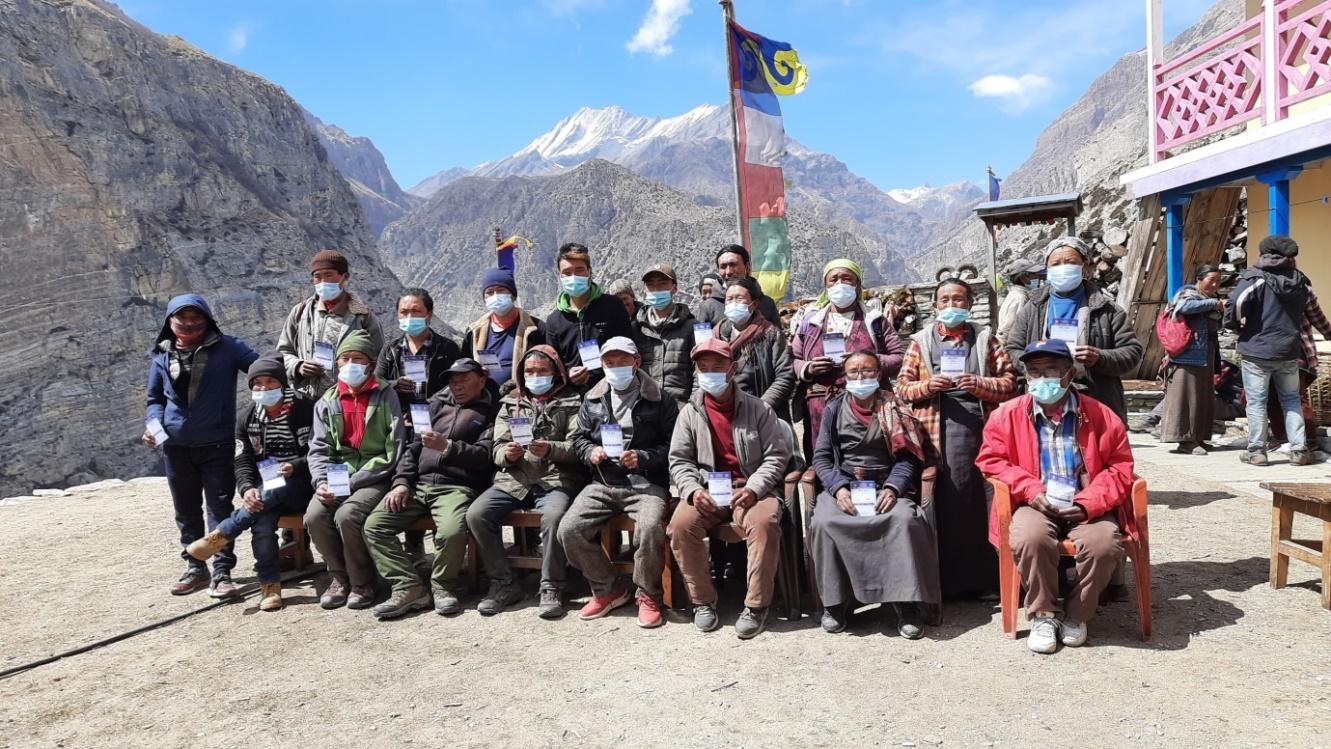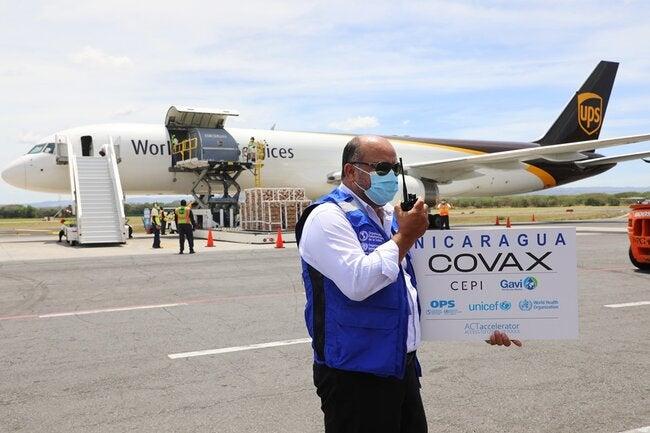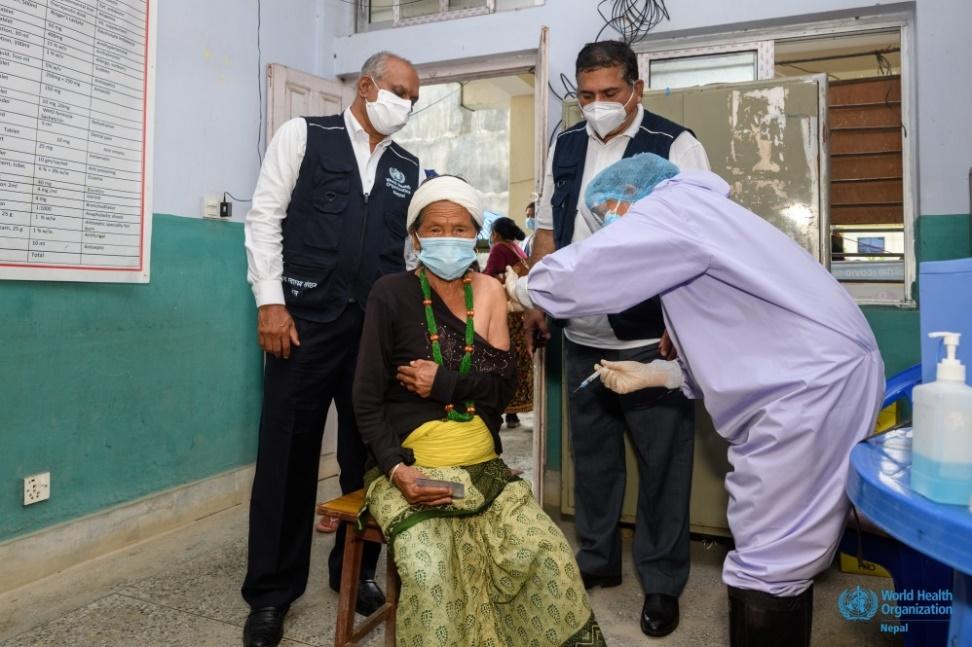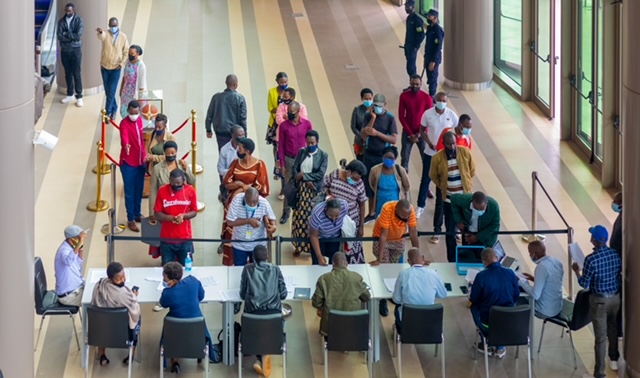WHO: An unwavering voice for vaccine equity
In 2021, as a limited supply of new COVID-19 vaccines trickled out, countries raced to ramp up vaccination as the pandemic spread around the world. The top priority of the World Health Organization (WHO) has been to ensure that all people, in every corner of the world, get their fair shot of COVID-19 vaccines, which is also key to ending the acute phase of the pandemic. Vaccine equity has been a major challenge between and within countries. In mid-2021, only 1% of the population of low-income countries had been vaccinated. And within countries, those most at risk of severe disease have not always been prioritized for vaccination. Yet, significant steps have been made, with an accelerated vaccine rollout and valiant efforts to vaccinate people in some of the world’s poorest and most remote areas. This article describes those efforts, with a focus on Nepal and COVAX.

Vaccinated adults in Nepal’s Manang district in the Himalayas. Credit: Badri Acharya, District Health Office chief
Nestled in the Himalayas, the far-flung Manang district of Nepal is not an easy area to access. Visitors must trek up a mountain, while supplies are usually brought up by ponies. The area is even harder to reach when snow, monsoon rain or landslides block access roads further down the mountain. It would be an unlikely frontrunner in any national vaccination campaign.
And yet, this remote mountainous area was one of the first districts in Nepal to vaccinate all its 4500 adults against COVID-19.
This remarkable feat was due to the Government of Nepal’s policy to prioritize vaccination of vulnerable groups, developed in alignment with WHO guidance. After vaccination of health workers, followed by the elderly nationwide, the vaccination campaign moved to hard-to-reach communities, including refugees and migrants. In June 2021, vaccines arrived in Manang by helicopter. Health workers trekked up the mountain on foot to administer vaccines.
Nepal’s exemplary efforts in ensuring vaccine equity, supported by WHO, helped protect communities that might otherwise have been overlooked.
Equitable access recognises we are not all on a level playing field. In the 2021 context of limited vaccine supply, it meant prioritizing vaccines to those needing them most, which has the greatest impact in reducing severe cases and deaths, and allocating resources to improve access everywhere.
In a pandemic, vaccine equity is not simply a moral issue. Leaving people unvaccinated allows the virus to spread and mutate further, increasing the risk of dangerous variants emerging, against which current vaccines might not be as effective. This could prolong the pandemic, deepening its socioeconomic impact and inequality.
"It’s really quite simple: the priority in every country, and globally, must be to protect the least protected."
WHO’s Director-General Dr Tedros Adhanom Ghebreyesus
The challenge of ensuring equitable access to vaccines in all countries
Throughout the pandemic, WHO has been a leading voice for equity and has worked for equitable allocation and distribution of COVID-19-related health products – from medical masks to oxygen – to people everywhere. Far before any COVID-19 vaccine was a reality, WHO was working to make vaccines available to all, beginning by supporting research and development by preparing“target product profiles”, which outline the necessary attributes of any potential vaccine.
In April 2020, a ground-breaking partnership pooling together several organizations was formed to ensure equitable distribution of new vaccines, diagnostics and therapeutics across countries – the Access to COVID-19 Tools Accelerator (ACT-A). Its vaccines arm was the COVID-19 Vaccines Global Access (COVAX) , which comprises WHO, the Coalition for Epidemic Preparedness Innovations, and Gavi, the Vaccine Alliance, in partnership with UNICEF.

A consignment of COVAX vaccines arrives in Nicaragua in March 2021. Credit: WHO/PAHO
In a triumph of science, COVID-19 vaccines were developed in record time. But distributing them equitably among countries proved far more challenging, with demand far exceeding supply because of limited manufacturing capacity and export bans due to domestic needs. Vaccine “nationalism” in wealthy countries constrained the supply further.
COVAX had to resolve legal and logistical complications and overcome supply bottlenecks and facilitate equitable allocation of available doses among countries. COVAX also supported 92 low- and middle-income countries in preparing for and introducing COVID-19 vaccines.
WHO’s emergency use listing procedure, to ensure that vaccines are safe and efficacious, helped to expedite regulatory approval in countries. And with partners, WHO supported countries in readiness and preparation to deploy vaccine (e.g., guidance, training, tools and communication materials).
The COVAX Facility succeeded in becoming the largest vaccine procurement and supply operation in history. It has been a lifeline for the world’s poorer countries, supplying more than 80% of vaccines to low-income countries.
In 2021, WHO launched a strategy to achieve global COVID-19 vaccination by mid-2022, which outlines the urgent actions required from the global community to vaccinate 70% of the world’s population against COVID-19 by mid-2022. The goal is to increase global population immunity substantially to protect people everywhere from disease, as well as to protect health systems, restore economies fully, restore the health of society and lower the risk of new variants. The strategy’s first aim is to protect health workers, older populations and high-risk individuals with important co-morbidities, advancing to all adults, followed by adolescents.

An Organization-wide effort to ensure equity within countries
With scarce vaccine supplies in 2021, countries had to make difficult decisions about vaccination prioritization. To help countries do this, WHO produced a policy document based on the advice from the Strategic Advisory Group of Experts on Immunization (SAGE), the WHO SAGE prioritization road map for use of COVID-19 vaccines in the context of limited supply.
All three levels of the Organization have worked to ensure vaccine equity so that no high-risk communities were left behind, with WHO’s country offices providing direct support on the front line and regional offices backstopping and adapting recommendations to regional needs.
The WHO SAGE guidance was the basis for Nepal’s prioritization policy. When Nepal received a shipment of vaccines through COVAX in June 2021, after 3 months in which no vaccines were received (then the case for many other low-income countries), the country decided to make the best use of the available doses
The WHO Country Office worked closely with Nepal’s National Immunization Technical Advisory Committee and the Ministry of Health and Population to tailor guidance locally, carefully weighing the vulnerability and risks of different groups.
“All measures were taken to save lives by protecting those at highest risk in the context of the barriers posed by limited COVID-19 vaccine supplies and a surge in COVID-19 cases,” said WHO’s Representative in Nepal, Dr Rajesh Pandav.
The immunization team at WHO’s South-East Asia Regional Office also assisted. “They worked closely with the country team to translate the SAGE guidance, develop the vaccine implementation plan, assess readiness for vaccine rollout and monitor the field implementation,” said Regional Director Dr Poonam Khetrapal Singh.
Nepal’s decision to prioritize the vulnerable, including migrants and refugees, during a period of scarcity of vaccines was “an extraordinary demonstration of political leadership” said Dr Vinod Bura, who led the WHO Country Office team for immunization. “It gave us real hope at a time when countries did not want to share vaccines.”
Equitable access requires ensuring country readiness for vaccination. Through its large field presence, WHO has supported countries to navigate various issues, such as bottlenecks in coordination, short shelf-life of donated vaccines, limited cold chain capacity and health worker shortages.
In Nepal, WHO Country Office staff cover almost every district and played an important role in explaining the rationale for prioritization of vaccination to local health workers. WHO also helped Nepal to ensure its readiness in all aspects, including planning, resources, regulatory processes, service delivery, training, monitoring, supervision, vaccine safety surveillance, communication and addressing misinformation, demand generation, cold chain and logistics. Details mattered: some of the vaccines received required different syringes, which WHO then purchased.
Vaccination has proceeded smoothly. Both the country and the Region are set to achieve the milestone of fully vaccinating 70% of the population by June 2022.
"Nepal’s successful COVID-19 vaccination drive is a powerful example of how high political commitment, coupled with the strong support of WHO and partners, as well as the donations of vaccines and a resilient health system, can protect the most vulnerable populations."
Dr. Dipendra Raman Singh, Director General Department of Health Services, Nepal
Supporting countries to ramp up vaccination
By late 2021, all but two countries in the world had introduced COVID-19 vaccines, in the world’s fastest, most complex vaccine introduction in history, supported by COVAX and its partners.
In 2021, 8.5 billion doses were administered globally, resulting in complete primary vaccination against COVID-19 of more than half the world.
The disparities among countries were, however, glaring – high-income countries were administering booster doses, while health workers in some low-income countries had yet to receive a first dose.
COVAX has worked to reduce that gap by adding additional COVID-19 vaccine products to their portfolio as they receive WHO emergency use listing. Also, as new vaccine products became available, WHO SAGE developed and updated vaccine product-specific recommendations, while all levels of WHO have worked to navigate the complex landscape of use of multiple vaccines.
In January 2022, COVAX delivered its one-billionth dose. With increased global COVID-19 vaccine production, there is now no longer a supply problem. Yet, the milestone was also a reminder of how much remains to be done for vaccine equity, including meeting the WHO target of vaccinating 70% of the population of every country by mid-2022.

There is still a long way to go to reach the 70% goal of people vaccinated in countries - in January 2022, 83% of people in Africa had yet to receive one dose. COVAX has a key role to play here, and supplied doses for this vaccination drive shown here in Rwanda. ©WHO-Andre Rugema
The revised WHO SAGE road map took into account increasing vaccine availability, vaccine coverage rates and the evolving epidemiological situation, including COVID-19 variants of concern, to assist countries in optimizing vaccination of priority groups with both primary series and booster doses. If doses are prioritized to those who need them most, more lives can be saved.
"If we vaccinate as many higher-risk people as possible everywhere, we can reduce the threat from the pandemic. We will see less hospitalizations and deaths from COVID-19 and our recovery will be faster," said Dr Kate O’Brien, Director of WHO’s Immunization, Vaccines and Biologicals Department.
Recognizing the urgency of turning vaccine doses into vaccinated, protected communities, WHO, UNICEF and Gavi, The Vaccine Alliance launched in 2022 the COVID-19 Vaccine Delivery Partnership, an inter-agency initiative built on existing COVAX multi-partner coordination mechanisms for country readiness and delivery that supported rapid delivery of vaccines to virtually every country worldwide in 2021. The Partnership is intensifying direct operational work to use resources globally, regionally and nationally to accelerate vaccination coverage in 34 countries that face the greatest challenges to achieving vaccination targets.
"We have the tools to bring the COVID-19 pandemic under control this year. But we are being undermined by rampant inequity."
WHO’s Director-General Dr Tedros Adhanom Ghebreyesus
Ultimately, improving access to vaccines for this or future threats will require building local vaccine manufacturing capacity and sharing licenses, technology and know-how, particularly in Africa, where a substantial gap in vaccine coverage remains and 90% of vaccines are imported.
To this end, WHO, with partners and a South African consortium, established a ground-breaking technology transfer hub for mRNA vaccines in South Africa to share technology and know-how with local vaccine producers. Two centres in Argentina and Brazil will be regional hubs for production of mRNA-based vaccines.
With the collective goal of ending the global public health emergency of COVID-19 in 2022, WHO’s Director-General Dr Tedros Adhanom Ghebreyesus, who has advocated tirelessly for vaccine equity, has called for a continued focus on this goal, backed by adequate financing.
By investing in vaccine equity, the world will move towards a healthier, safer, fairer future.
